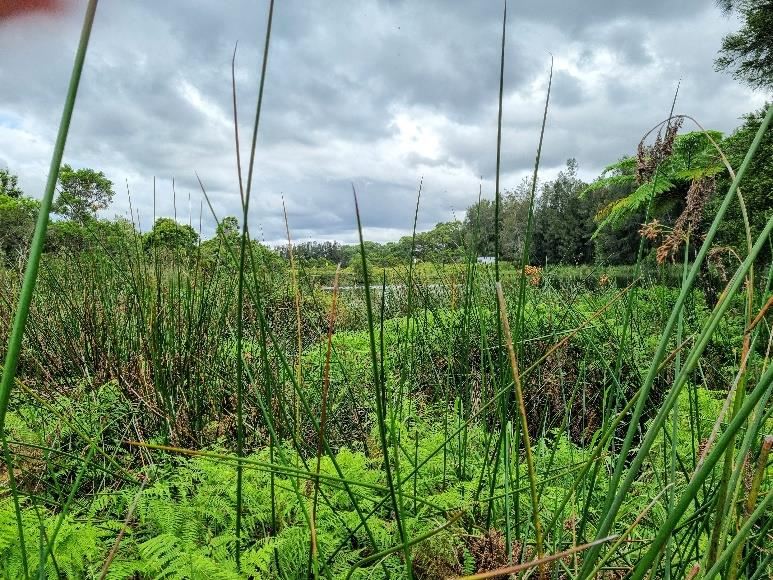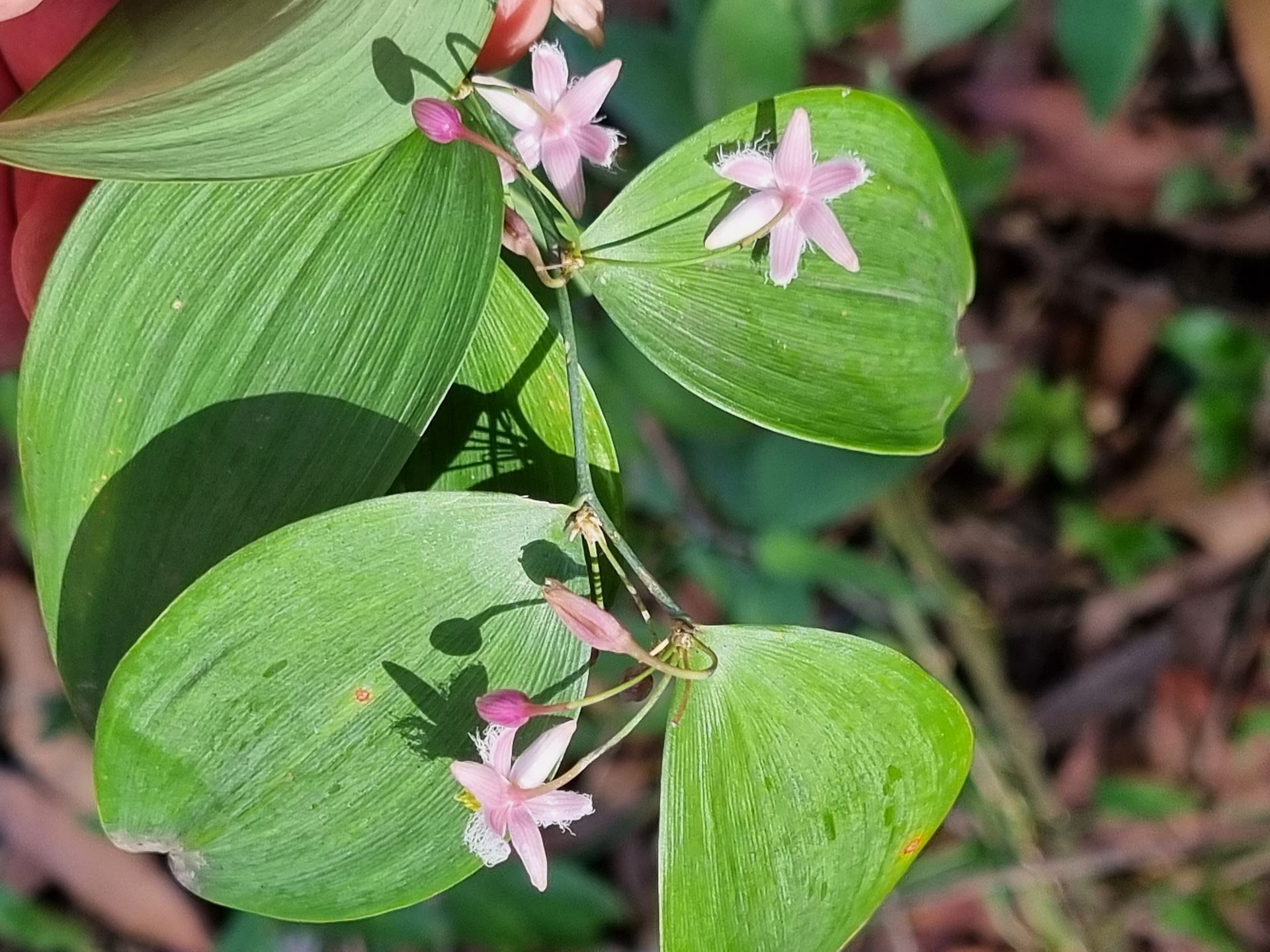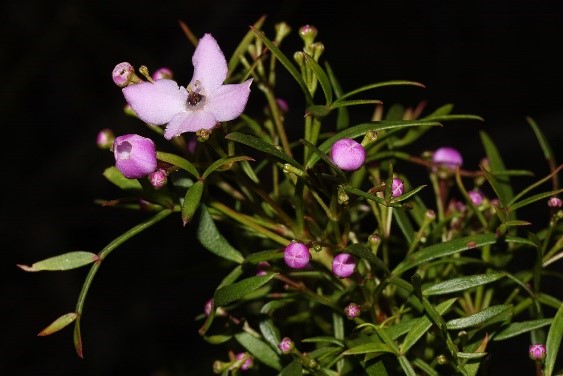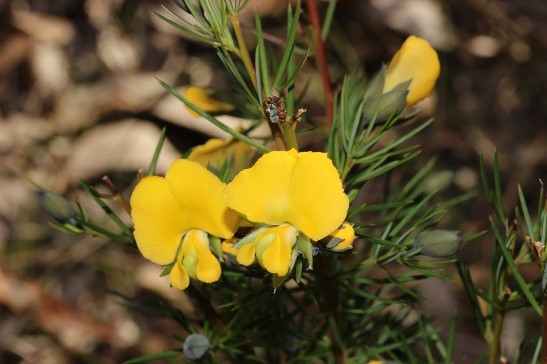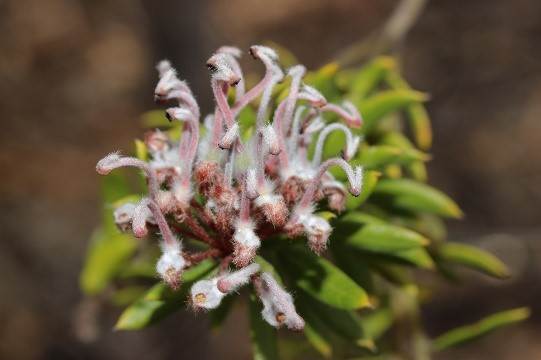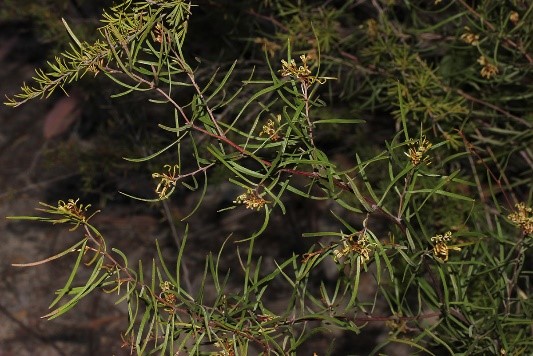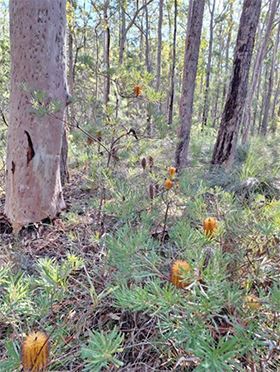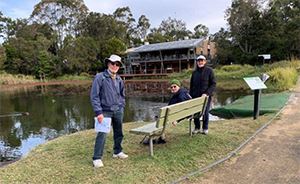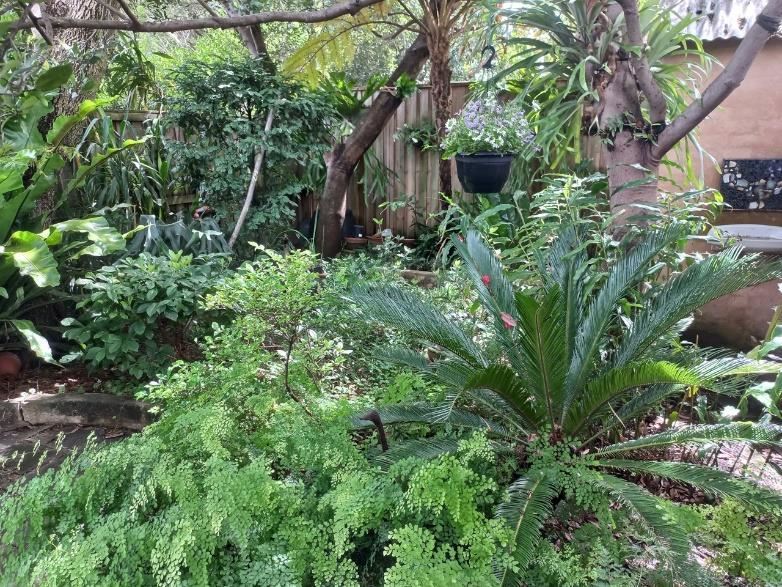| Parramatta and Hills District Group |
Group News 2025 |
MUOGAMARRA NATURE RESERVE - Sunday 24 August
Photo James Indsto What a fabulous day we all enjoyed at Muogamarra Nature Reserve which is only open annually to the General Public for six weeks! Right from the moment we entered the Reserve with a friendly welcome by the NPWS volunteers, we all had a sense that it was going to be something special and special it was! For more, see the Trip ReportWATERFALL WALK BIDJIGAL RESERVE - Saturday 24 MayBlue Gum Creek crossing Eleven members met to walk this 3.1 km walk through the northern end of Bidjigal Reserve at West Pennant Hills. There had been heavy rain until the day before but the sun shone for us and we managed to dodge the puddles on the fire trail. We were rewarded with cascades on Darling Mills Creek and a large volume of water coming over the waterfall. The walk starts in remnant Blue Gum High Forest and then descends into Sandstone Gully Forest. At the lowest point on the track the sandstone cliffs are quite impressive. At the base of the cliffs there are dense stands of Christmas Bush and Callicoma. The track then opens out into Sydney Peppermint Gum Woodland before crossing Blue Gum Creek where more Sydney Blue Gums can be seen. With such a variety of plant communities we easily noted 50 different species. However, after so much rain in the previous two weeks there was also a very impressive range of fungi on show. Unfortunately, our expertise did not extend to identifying many of them but we all decided we were not going to gather any to make Beef Wellington for dinner. The walk ended at Linda Pine’s home nearby where we enjoyed the outlook of more Blue Gums from her back deck and delicious Lemon Myrtle biscuits. Many thanks to Linda for her hospitality and to James Nash for his lovely photos. Jennifer Farrer Australian Plants Society – Parramatta -Hills APS. |
 |  |  |
| Leucopogon microphyllus | Micromyrtus blakelyi | Brachyloma
daphnoides |
 |  |  |
| Viminaria juncea ? | Lomandra multiflora | Thelymitra ixioides |
Weekend away up north
Pip Gibian
On Saturday 27th May, eight of us congregated at the country property, ‘Parragilga’, of Phil Baird, one of our members. It is in an area called The Branch, north of both the Hunter and Karuah Rivers, and east of Buckets Way, the road to Gloucester. The property once belonged to a logging family, but for a very long time has been untouched and allowed to regenerate. It is woodland with tall trees, grasses and a variable collection of not very high under-shrubs. There is remarkably little weed. Phil has had a botanist flora survey done for the council, which shows over 200 different species.
Initially, we had a small walk around the level of the house, the highest part of the property. The most common tree species are Eucalyptus fibrosa, an ironbark, and Corymbia maculata, a spotted gum. Acacia terminalis was flowering, a pale-yellow form. Near the house, Phil had planted Grevillea guthrieana, an endangered plant only found in this area and around Buladelah.
After lunch, we had a longer walk down the slashed fire trails to the main attraction at this time of year. Quite a large area supports a great many Banksia spinulosa plants, flowering furiously. They show a collection of different colours in their styles. Some are bright gold, or various shades of red, and some are very dark, almost black. They are beautiful. Because of a recent severe storm over Newcastle, the fire trails became increasingly wet, so we didn’t progress to the strip of rainforest flora along the Branch River, one of Phil’s boundaries. Light was fading fast by the time we left. Many thanks to Phil, who is a great host.
Plants seen by the group included:
| Acacia falcata Acacia floribunda Acacia longifolia Acacia myrtifolia Acacia terminalis Allocasuarina torulosa Banksia oblongifolia Banksia spinulosa Billiardiera scandens Bursaria spinosa Corymbia gummifera Eucalyptus maculata |
Daviesia ulicifolia Epacris pulchella Eucalyptus fibrosa Glochidion ferdinandi Glycine clandestina Glycine tabacina Hardenbergia violacea Isolepis inundata Kennedia rubicunda Leptospermum polygalifolium Leucopogon juniperinus |
Lomandra longifolia Lomandra obliqua Notelaea longifolia Ozothamnus diosmifolius Parsonsia straminea Persoonia levis Persoonia linifolia Pratia purpurascence Pultenea villosa Zieria smithii |
Five of us stayed in the area overnight and met at 10 am at the Hunter Wetlands Centre in Shortland, an outer suburb of Newcastle. If you are going there, be aware that there is also a Hunter Wetlands National Park, a different place altogether. The Shortland one has a collection of large ponds, swamps and marshes, populated by a great variety of Australian water birds: ducks, swans, egrets, geese, moorhens and many more. A network of paths winds around these with some bird hides and other interest points. There is an enclosure featuring a freckled duck, pretty with dark plumage and small yellow spots. The signage explains that this is a very primitive species of duck.
The Newcastle District APS Group is heavily involved with the Wetlands, and has planted
native plants around the Centre building. They also sell plants produced by their very active
propagation group. The Centre is a two-story building, giving a view over the wetlands. It
contains lots of explanatory maps and leaflets, a shop and a very good café, with a large
verandah area, as well as education facilities on the lower level. On walking around the
wetlands there are areas of rainforest. There is also a very good wild food display area,
showing lots of labelled plants, and signs explaining the uses of many of them. A visit here is
different from our usual activities, and is very interesting and worthwhile.
Thanks to Pip, Ricki and Jennifer for these photos from the weekend away.
 |
 |
 |
 |
 |
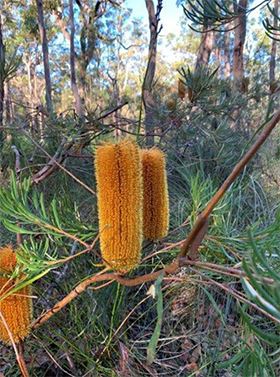 |
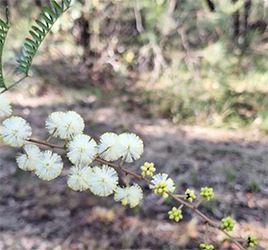 |
 |
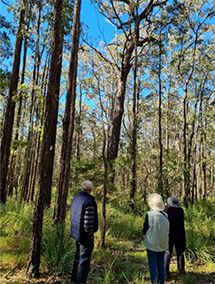 |
 |
|
|
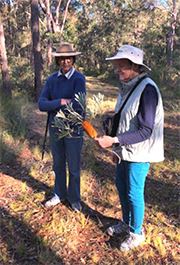 |
View from the Cafeteria, |
Ron, Barbara and Joan, |
OBSERVATIONS ON DIURIS POLLINATION IN NEW SOUTH WALES
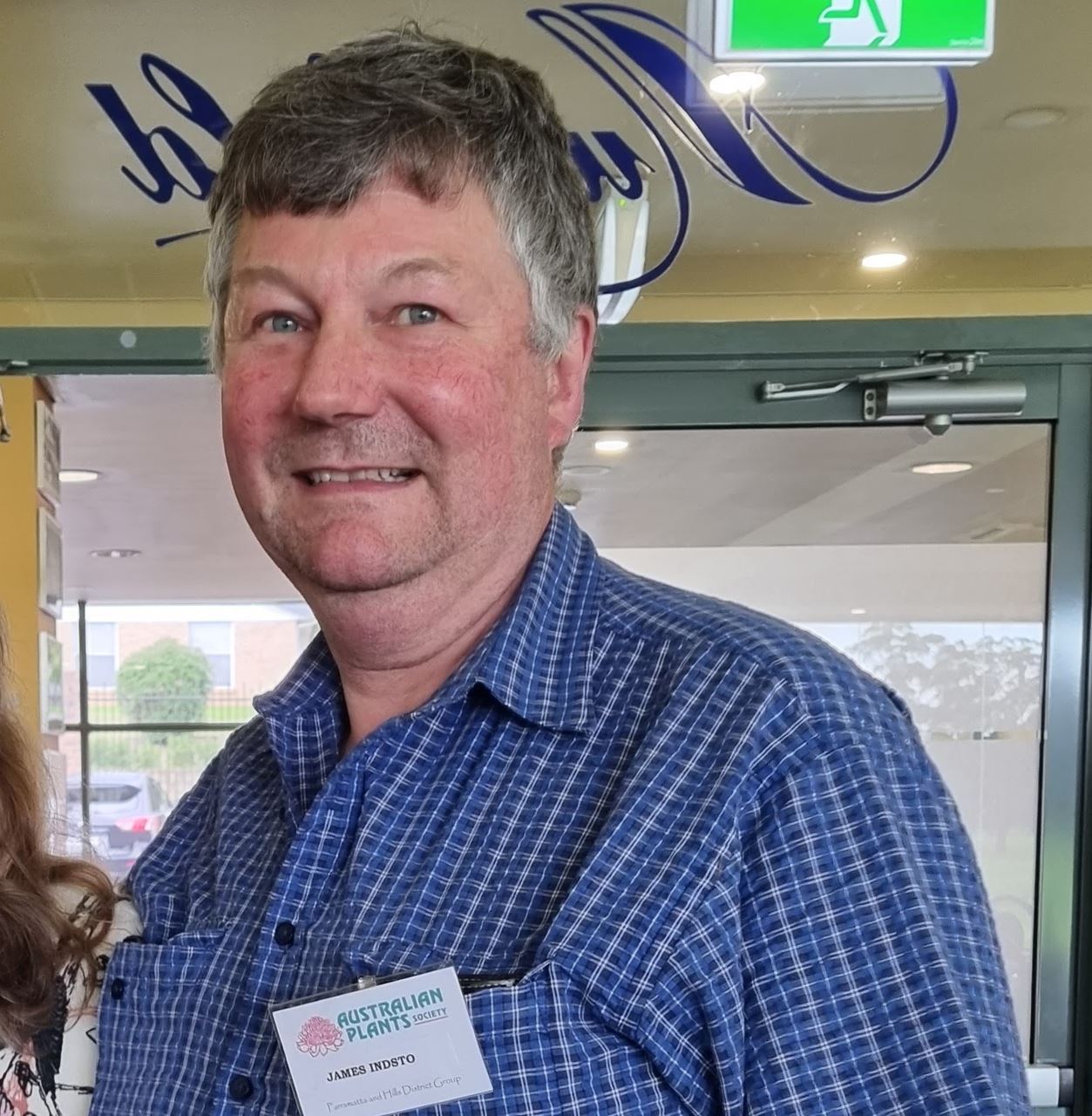 This was James Indsto's talk to our April meeting. It was based on research which he undertook for his Master of Science degree.
This was James Indsto's talk to our April meeting. It was based on research which he undertook for his Master of Science degree.
The phenomenon of species imitating other species for their own advantage was first observed in the middle of the 19th century, when the English naturalist Henry Bates observed non toxic butterflies imitating the colours and wing patterns of toxic butterflies. African orchids have been observed being pollinated by butterflies even though they do not offer the butterfly any reward.
In NSW Diuris orchids have been observed growing in close proximity to yellow pea flowers. When the nectar guides on the pea flowers are observed under ultra violet light, these visual cues are much closer to the patterns on Diuris orchids. Bees can see in this part of the light spectrum and thus encouraged to visit the orchid even though there will be no reward for them when they do.
Diuris aequalis mimics Gompholobium flowers. Diuris maculata mimics the “eggs and bacon" flowers of Daviesia and Bossiaea flowers. Even the pink flowers of Diuris punctata mimic the yellow flowers of Dillwynia glaberrima sufficiently enough to ensure visitation by species of native bees.
James collected pollen from bees and found pollen on their pollen receptors and bodies from both orchids and pea flowers. He also studied the pollination rate of the orchids. At 20% it was sufficient to ensure continuation of the species.
James mapped the growing pattern of the orchids amongst the pea species they were imitating and found that orchids growing within 10 metres of the pea plant were the most likely to be pollinated
These findings will give us another activity for our spring bushwalks. Next time we see a Diuris orchid we should look to see which pea flowers it is imitating.
WINDSOR DOWNS WALK
Saturday 25 March
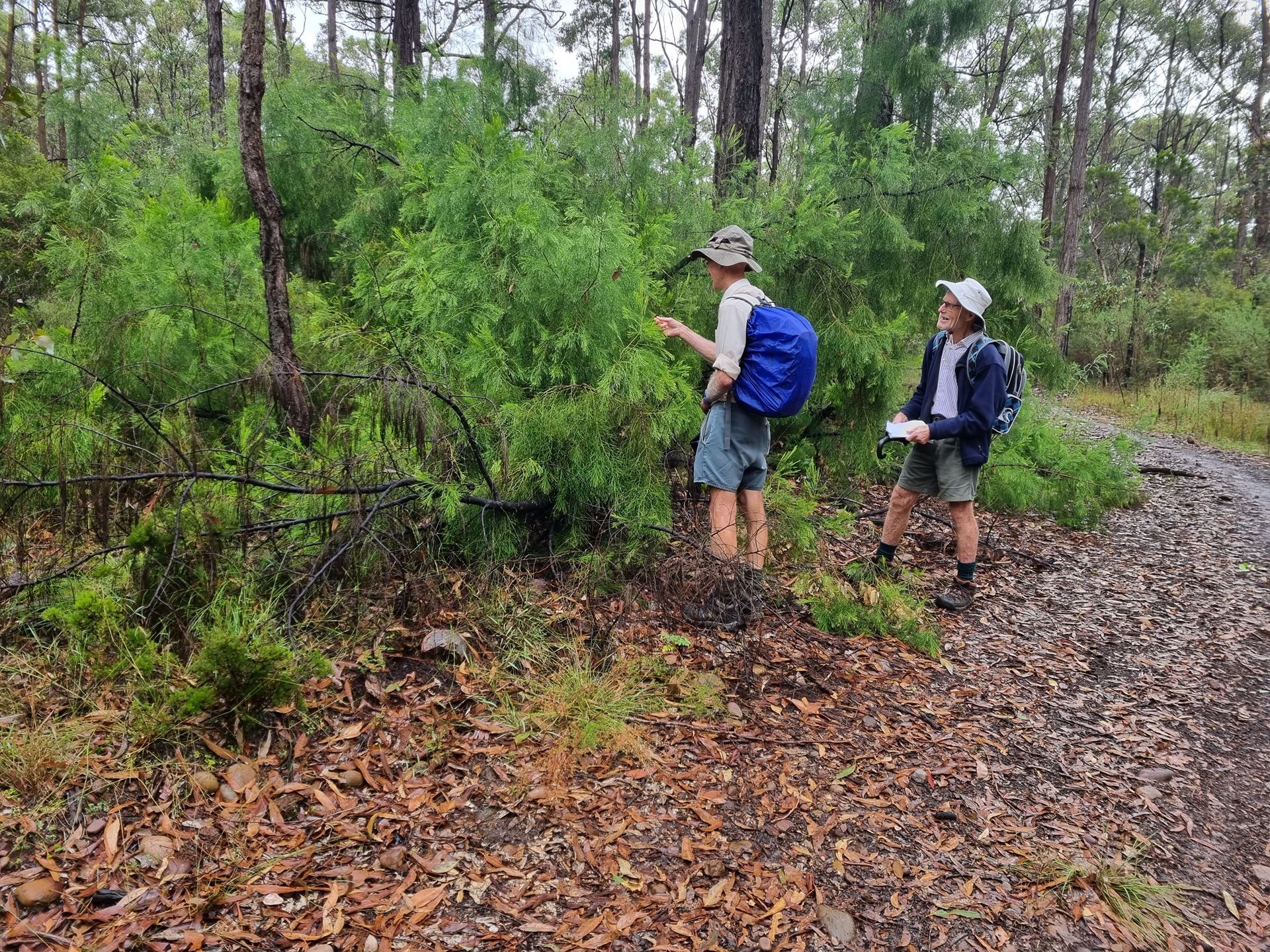
The weather forecast was not very encouraging but when the BOM site said 25% chance of one millimetre at 2 pm nine members were prepared to risk it.
The route we took was part of the tour which Jennifer and Pip had developed for the post conference tour last year. So we met at the entrance to Mc Corns Trail and wandered a few metres in to look at Persoonia nutans, one of several endangered plants growing in the reserve. While we were there we also saw several plants of Styphelia laeta already flowering, which was quite a surprise.
We then drove to the start of the Hakea Trail. This is very aptly named as it has wall to wall Hakea sericea on both sides of the track. It wasn’t flowering of course but right on the track were large patches of Goodenia paniculata which made a very attractive display. Very soon we started to see large numbers of Darwinia tenuifolia, another of the endangered plants in the reserve. It was also at about this time that we found that we had scored the 1 in 4 chance of rain. It was amazing how quickly the puddles started to form, so it was a wet progress to our next endangered plant, Pultenaea parviflora.
Beyond this was the wall of the dam built to provide water for the cattle which grazed here before meeting their demise at the Riverstone Meatworks. The reserve was used for grazing cattle for more than 100 years, then in 2013 it was burnt in a wild fire so it is amazing how well the vegetation has recovered. On earlier visits we have found the area below the dam wall to be a flora hotspot but the rain was a deterrent to closer botanising here.
We returned to our cars via the Dip Trail through Shale/ Gravel Transition Forest. There were quite a few Melaleuca nodosa here as well as one of the largest Exocarpus cupressiformis any of us had ever seen.
Windsor Downs is a very rewarding place to visit. The trails are almost flat and there are plants to see which are unique to this part of Greater Sydney.
A WIDE AND OPEN LAND
Saturday 25th February 2023
This the title of Peter Ridgeway’s book telling the story of his walk across the Cumberland Plain in 2019. We were fortunate to have Peter as our guest speaker at the February meeting.
The Cumberland Plain is an area of 2750 square kilometres surrounded by the sandstone curtain of the Hornsby and Woronora Plateaux and the Blue Mountains. It was the homeland of the Darug, Gundungurra, Dharawal and Darkinjung peoples. After European settlement it became the food bowl of the colony.
It is a unique ecosystem whose status is now dire. It is home to unique flora and fauna, all of which now have a threatened status. 7% of the vegetation remains but only 2% is conserved and one per cent is public open space. Remarkably Peter, was able to trace a route through the Cumberland Plain through the remaining rural bushland with only some walking through suburbia. This was a route of 178km which he completed in 8 days, camping out at night.
• Scheyville National Park
This area is the remains of the Pitt Town Common created in the 18th century to provide common land for grazing and foraging for local settlers. It is on the edge of the Cumberland Plain and actually had a sandstone quarry. It has had many uses over the years including hosting several labour immigration schemes and officer training for the military. It was declared a National Park in 1996. The vegetation is mainly regrowth because of its former use as farmland. However, there is great diversity ranging from Grassy Box Woodland to Rainforest. Longneck Lagoon is a special place. You can find the orchid Pterostylis saxicola in the park, which is only found on the borders of the Cumberland Plain.
• Londonderry – Castlereagh
This area is defined by large amounts of sediments from an ancestral Hawkesbury River which are comprised of a mixture of sandstone and shale. As this area had no agricultural value it has been conserved. The largest patch of intact bushland is the 448 hectares of Castlereagh Nature Reserve. Also in this area is the unique Agnes Banks Nature Reserve which is 50 hectares of pure sand over the original river deposit.
All the endemic species of the Cumberland Plain are found in Castlereagh NR including Dillwynia tenuifolia, Grevillea juniperina, Allcasuarina glareicola, Pultenaea parviflora, Micromyrtus minutifolia and Persoonia nutans.
• Shane’s Park
This 558 hectares site will become Yeraldea NP. It has vegetation similar to Londonderry Forest but has never been strip-mined or logged. The land was purchased in the late 1960’s to install very low frequency antennae for air navigation. This passive use of the land has conserved the vegetation. This includes one of the only intact Chain-o- Ponds meadows to remain in the Cumberland Plain. This unique system is a series of freshwater ponds from which the water flows under the surface through the alluvium sand belt above the clay. Most have now been destroyed by erosion.
• Western Sydney Parklands
This large parkland was compulsorily acquired from farmland in 1972 to become a green belt. There has been a revegetation progam and there are also patches of old growth forest. It has a very large network of walking and cycle trails, many of them concrete. One of the special flora growing there is Pimelea spicata which has a very limited range. It only occurs here and in the Illawarra. Another feature of this plant is it longevity. Plants have been recorded living more than 50 years
• Elizabeth Macarthur Agricultural Institute – Cowpasture Plains
The EMAI area includes intact rainforest. Peter showed us photos of some very large trees which he thinks are a natural occurring hybrid of Eucalyptus botryoides and Eucalyptus saligna. There is also another intact Chain-o-Ponds Meadow. He added to this photo emus, kangaroos and sulphur crested cockatoos, the animals which frequented the Chain-o-Ponds as described by Caley. Sulphur crested cockatoos have only taken up residence in the Sydney suburbs in the last 50 years. Probably because of the abundance of food.
Peter concluded his talk by telling us that there is no such thing as The Cumberland Plain! It is name created by botanists in the 1980’s to describe the various vegetation communities found there. Like the word Brush which in the 19th century described rainforest, the word Plain now also has a different meaning. A Plain was an area without trees that was not necessarily flat. And it is not even in the County of Cumberland!
MEMBERS’ MEETING 28 JANUARY 2023
On Saturday 28 January we revived an old tradition in our Group of meeting in January to share photos and stories of our gardens and places we had visited.
As we are lucky to have such a lovely covered outdoor area at Gumnut Hall, we utilised it to meet for a BBQ/picnic lunch before the meeting. It was lovely to see so many members come along for this social event. Although the weather was hot and humid, a gentle breeze and the shade kept us cool enough.
At the meeting we viewed the Powerpoint presentation that Alan Wright had prepared for our 50th celebration of photos of past activities. He has now added photos of the 50th celebration. This will now go into our archives box as a valuable record for the future. Many thanks to Alan for putting this together. We are so lucky to have someone of his talents contributing to our program.
Jennifer Farrer, Lesley Waite, Jim and Ricki Nash and Pip Gibian showed photos from their gardens and bushwalks.
We then adjourned for a sumptuous afternoon tea and more informal sharing and socialising.
Jennifer Farrer
Group News 2022
Return to Quarry Road Dural - 22nd October 2022
Despite forecasts of storms, seven of us met at the end of Quarry Road and walked for two hours in fine weather. We had been told by Jim and Ricki Nash that there were terrestrial orchids to be seen there and we were not disappointed. We saw several patches of Calochilus robertsonii. The Purple Beard Orchid.
Quarry Road has been a favourite place for us to walk for many years. It is quite flat and the diversity of plants is truly amazing. The continual rain this year has meant that the flowering season has been longer and later than usual. So on this Saturday afternoon in late October we saw many plants still flowering. For example there was a lone Woollsia pungens, looking a little tired but still flowering after probably six months. Some Grevillea speciosa still had flowers as well.
Overall we saw and identified 64 species. Highlights were masses of Dampiera stricta, more Conospermum longifolium than I have ever seen before and extensive patches of Boronia pinnata and floribunda.
 |  |
| Boronia floribunda | Conospermum longifolium |
The smaller group enabled us to really examine and identify some smaller inconspicuous plants which are often overlooked such as Micrantheum ericoides, Stackhousia viminea and Gonocarpus teucrioides .
After much discussion it was decided that this plant was Poranthera ericifolia.
Jennifer Farrer
Jones Road Fire Trail walk Kenthurst - Saturday 23 July
Photo: Tony Maxwell
For our second bushwalk this year we were a little apprehensive, as showers were forecast. We were all kitted out and ready for the usual bad weather, but, guess what? – it was fine!
This fire trail is on a ridgetop of Hawkesbury Sandstone, and the flora is very diverse. One of the post-conference tours from Kiama is calling here in September. Wendy and Sue from the North Shore Group, experts on this type of flora and who will be tour guides, were with us today.
One of the upsides of this walk was that we were able to identify the beautiful Boronia that is widespread here. Previously we thought it to be Boronia ledifolia, but thanks to Wendy and Sue, concluded that it is B. rubiginosa.
Another positive was that we updated the plant list for this area, which will be included in the tour booklet. Thanks to Tony for the printed copies he handed out.
Something I noticed on this walk was that a few plants were flowering later than usual. This is the case too in the bush at my place just down the road. Leucopogon fletcheri, Boronia floribunda, Styphelia triflora, Calytrix tetragona, amongst others, were yet to flower. Perhaps this is because of all the rain we’ve had this year?
Here are a few of the stand-out plants on this walk:
 | 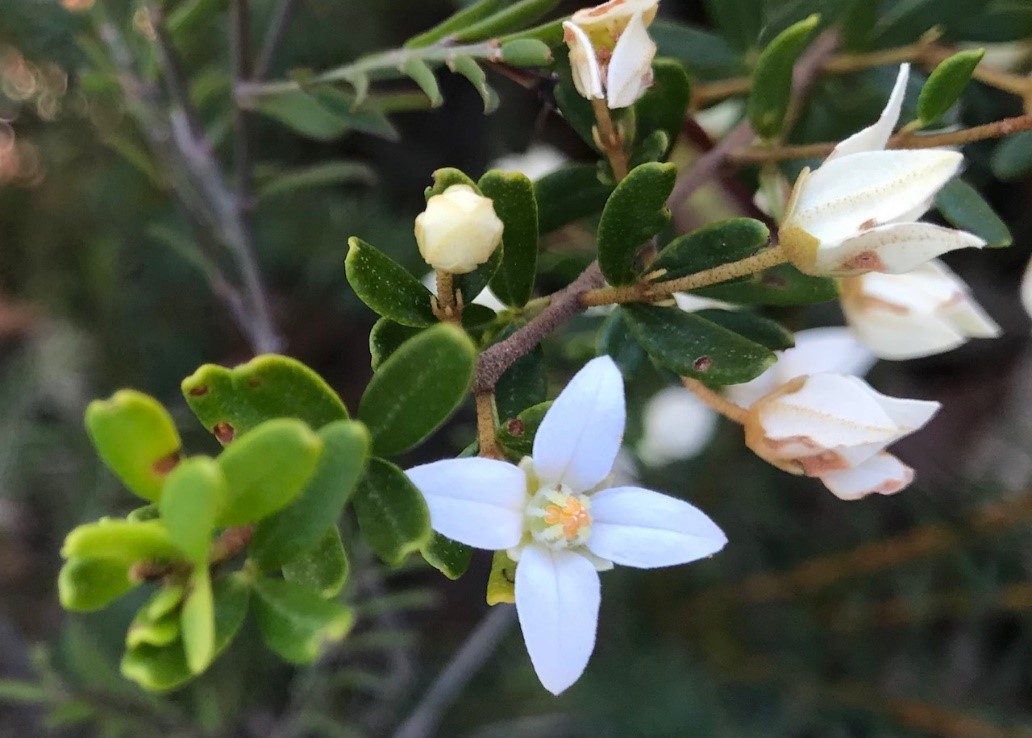 |
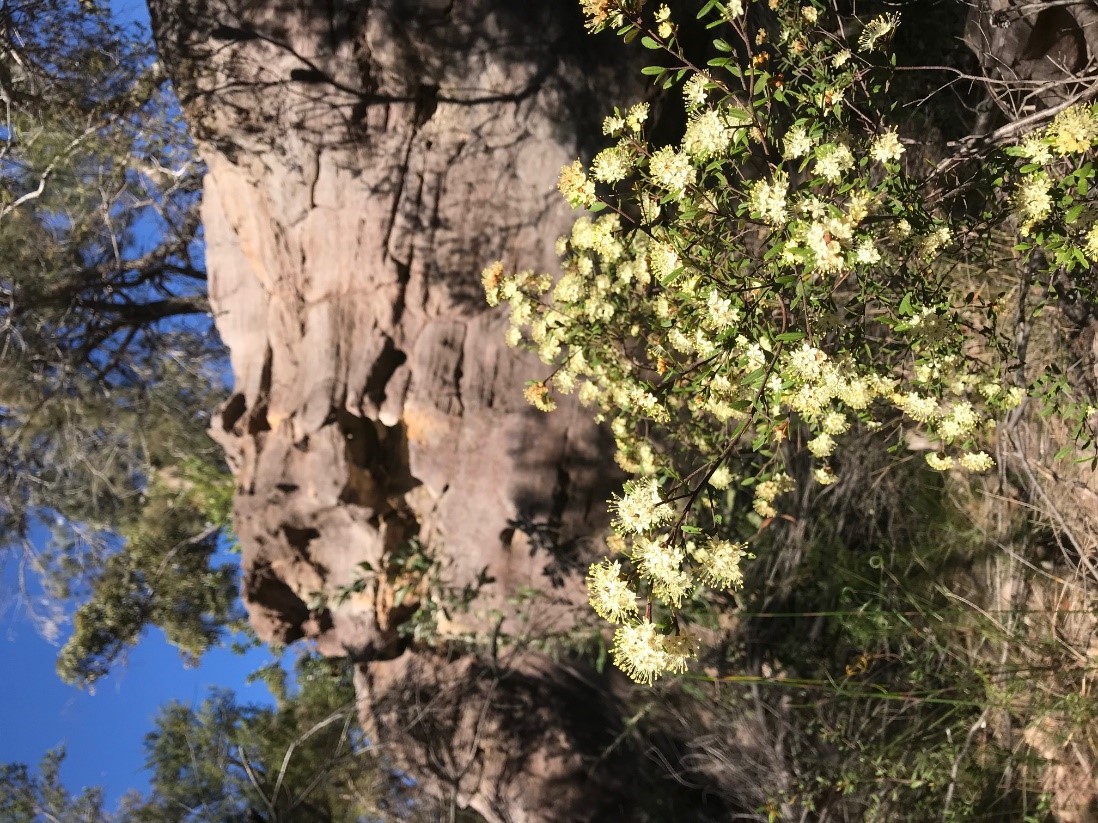 |
Top: Boronia rubiginosa, pink and white forms. We found the white one on a walk here last year.
Bottom: Wollsia pungens, and Phebalium squamulosum.
All photos Lesley Waite.
PORTERS ROAD FIRE TRAIL WALK - 23 April 2022
Our April walk was planned to be at Vineyard Creek, Telopea but the recent heavy rains had made the track conditions very muddy so it was decided that a walk along a ridge might be a drier option.
There are not too many ridge walks in The Hills as the ridges were originally cleared for farms and orchards in the 19th century and then gradually subdivided for suburbs in the 20th century. However, there remains an excellent uncleared sandstone ridge at the end of Porters Road Kenthurst. This area was also slated for subdivision but community pressure ensured that it remains to be enjoyed by many of us today.
Twelve of us set forth on an afternoon which remained delightfully sunny even though the forecast had been for showers. There have been several fires in this area including 1975, 1992 and 2002. After the 1992 fire, members of the Parramatta Hills Group pegged out several sections which were periodically monitored for regrowth. These records are still held by our group. Unfortunately, the pegs were burnt in the 2002 fire so it is not possible to identify the exact sites.
Apart from one section of the walk where the dominant vegetation is casuarina woodland with little or no under storey the flora diversity seems to have survived the fires.
Tony Maxwell had prepared lists of species likely to be found in the area and the keen eyes of members enabled us to identify 106 species in two and a half hours. Credit needs to be given to Chris Cheetham whose wonderful knowledge and keen eyes identified some of the smaller species amongst grasses on the road margin which everyone else had walked past. This included a largish patch of Pimelea curviflora and an early flowering Tetratheca ericifolia which for a short while was thought to be the much rarer Tetratheca glandulosa. We did see one rare plant though. There were two plants of Persoonia hirsuta.
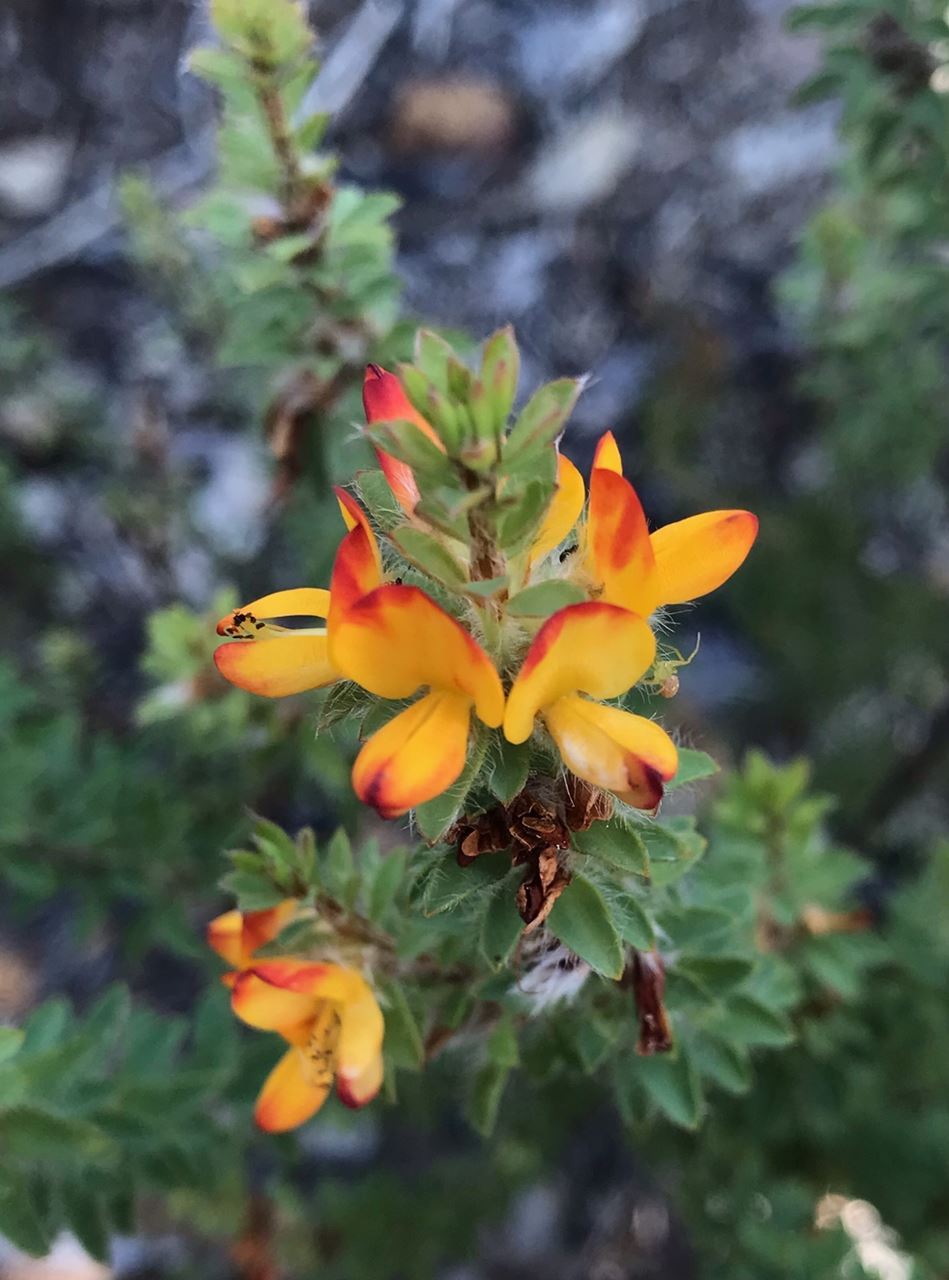 |  | 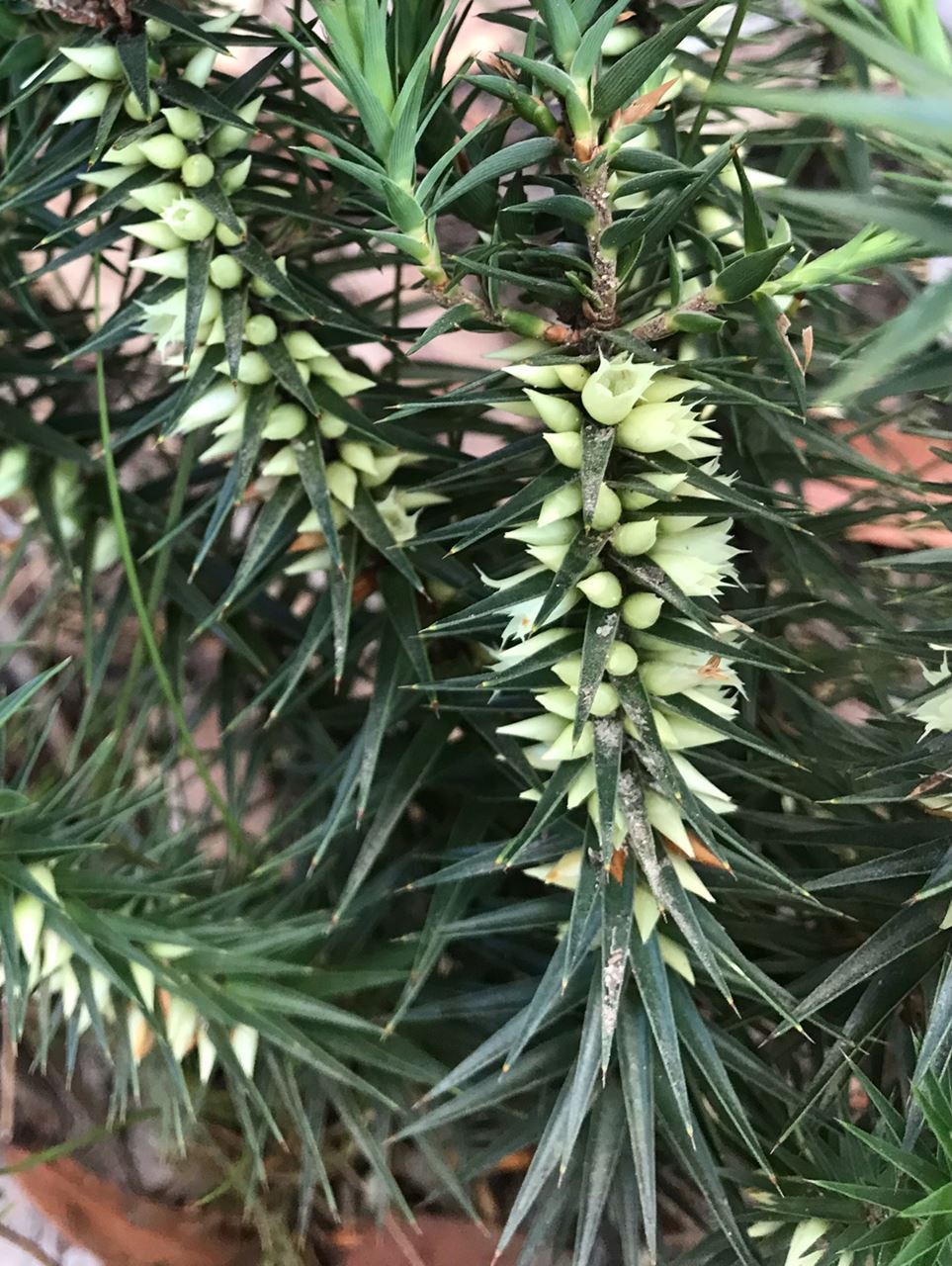 |
| Pultenaea tuberculata | Persoonia hirsuta | Melichrus procumbens |
Jennifer Farrer
Talk on Shady Gardens by Angie Michaelis 26th March 2022
Angie Michaelis was the speaker at our meeting on 26 March. As well as being an experienced horticulturist she also has a garden with only one small sunny patch.
Photo: Angie's backyard
Inspiration from Nature
When thinking about designing a garden in a shady area it is always good to think about plants which grow in a shady environment. Rainforests are a good source of inspiration. In a rainforest there are many different light levels and layers of plants. There is the canopy above, plants which are growing on tree trunks such as epiphytes and ferns, climbers twining around trunks and the plants growing on the forest floor. The predominant colour is green but there are many different shades of green from green/brown to green/white with an occasional flash of colour. There are also many different leaf shapes and textures.
Understanding Your Site
What is causing your shade? Is it a solid wall or tree canopy? Is it shady all day/year? Often there will be sun at some times of the day/year. The shade maybe dense or filtered through the leaves of your canopy. Is the problem really shade or lack of water? Often plants struggle more from root competition than from the shade of the canopy.
Possible solutions
- Removing trees entirely is not a good idea as gardens feel best with at least one tree to provide shape to the garden.
- Broad leaved plants and ferns have evolved to get enough light in a low light environment.
- Prune shrubs or canopy trees from below to let in more light
- Use tree trunks to display epiphytes
- Areas with summer sun and winter shade are the most difficult to manage. The best solution is to plant something which is happy in the sun but not to expect too many flowers because of the shady periods.
- Look at ways to increase the water to areas where there is competition from tree roots. Often in these situations it is better to use pots or raised beds.
Plant Selection
Up High
Use trunks to grow Birds Nest and Stag ferns, orchids, climbing ferns, climbers such as Hibbertia dentata, Pandorea jasminoides or pandorana, Clematis, Eustrephus latifolius,
Understorey trees such as Backhousia myrtifolia, Dodonaea viscosa, Tree ferns
Structural plants such as Cordylines and Gingers
Baskets for ferns or Viola hederacea
The Middle Storey
Shrub Layer Indigofera australis, Correa bauerlenii, or reflexa, Graptophyllum ilicifolium or spinigerum, Hymenosporum “ Gold Nugget”, Rhododendron lochae, Croweas, Boronias, Bursaria, Philotheca, Syzygium, Pittosporum revolutum, Prostanthera scutellaroides, Zieria, Austromyrtus dulcis, Pultenaea blakeyi, Grevillea shiressii,
Structural Plants Cycads
Ground Covers
Hibbertia, Dichondra repens, Violas, Doodia aspera, Adiantum hispidulum and other ferns, Zieria prostrata, Podocarpus spinulosa, Goodenias, Ajuga, Brunoniella, Dianellas, even mosses.
Change in the Garden
Change is inevitable in the garden. Look for different solutions to problems.
Reinvent your garden. Do you need to keep trying to grow plants under a large tree. Maybe the solution is paving, a seat , a sculpture or a pool.
Talk by Prof. Michelle Leishman 26th February 2022
 At our February meeting, the speaker was Prof. Michelle Leishman from the School of Biological Sciences at Macquarie University. As well as being a botanist, Michelle has extensive knowledge of climate change, particularly its effects on plants and the urban environment. She started her talk by reiterating some of the irrefutable facts about climate change, illustrated with graphs. We know that the average temperature of our city is rising, and that average rainfall is falling, particularly in our far western suburbs. What can we do now to ensure our suburbs remain liveable despite these facts? It is now proven that on hot Summer days, leafy green suburbs remain cooler than those with little vegetation and open parklands. Aerial photos with heat-sensitive cameras clearly demonstrate this. To counteract climate change we need to increase areas of vegetation between our buildings and expand current green spaces. As housing blocks become smaller and houses larger, there is little space left for trees or any living plants. Planning laws should change to reflect the need for increased green space in the future. Tests show that trees reduce temperatures more than green grass, by providing shade. As well as lowering summer temperatures, trees help combat pollution, reduce carbon dioxide in the atmosphere, provide habitat for birds and other animals and have beneficial physical and psychological effects on the human inhabitants. This latter fact was clearly demonstrated during COVID lockdowns.
At our February meeting, the speaker was Prof. Michelle Leishman from the School of Biological Sciences at Macquarie University. As well as being a botanist, Michelle has extensive knowledge of climate change, particularly its effects on plants and the urban environment. She started her talk by reiterating some of the irrefutable facts about climate change, illustrated with graphs. We know that the average temperature of our city is rising, and that average rainfall is falling, particularly in our far western suburbs. What can we do now to ensure our suburbs remain liveable despite these facts? It is now proven that on hot Summer days, leafy green suburbs remain cooler than those with little vegetation and open parklands. Aerial photos with heat-sensitive cameras clearly demonstrate this. To counteract climate change we need to increase areas of vegetation between our buildings and expand current green spaces. As housing blocks become smaller and houses larger, there is little space left for trees or any living plants. Planning laws should change to reflect the need for increased green space in the future. Tests show that trees reduce temperatures more than green grass, by providing shade. As well as lowering summer temperatures, trees help combat pollution, reduce carbon dioxide in the atmosphere, provide habitat for birds and other animals and have beneficial physical and psychological effects on the human inhabitants. This latter fact was clearly demonstrated during COVID lockdowns.
These factors lead to difficult decisions about what to plant to increase urban vegetation. Damage to old established trees has already been seen during heat waves, with leaf burn and even plant death. What we previously planted as street and park trees may no longer cope with increasing climate change. The need for evidence-based decisions has triggered the WHICH PLANT WHERE project. For about five years, Michelle has been heavily involved with a group of researchers, studying and testing a large number of native plant species, looking for resistance to high temperatures and low water availability. The results have lead to the development of the WHICH PLANT WHERE website, which is to be launched in March or April this year. The team has incorporated test results with facts about the occurrence, natural habitat, rainfall and usual growing conditions in the wild of a very large number of native plants. The collated information is being used to recommend which species to plant in a certain area. Some further specifics were added, including a description, size and shape, whether the plant has poisonous fruit, or is likely to drop large limbs.
In the WHICH PLANT WHERE website, you can enter a postcode and be given a large list of appropriate plants. Your search can be narrowed down by adding further requirements, eg asking for a shrub or tree of a specific size, and choosing whether it is for a home garden or a public park. The listed plants include further information and a photo. The results have been further divided into how hardy a species is likely to be under future conditions. This is done with a “traffic light” coding, green for good, orange for not as good and red for not likely to do well. This coding has three time zones, namely now, in a few years, and in many years. Some recommended species will be designated “green” now, but may in the long-term be in the “red” category, as climate change worsens. The website covers the whole of Australia, suburban and rural, including all postcodes. Of course, conditions can vary in a suburb and also in a home garden, so the website does have limitations. However, this will be the only reference available for information which considers the effects of climate change on the growth of a native plant.
Pip Gibian








